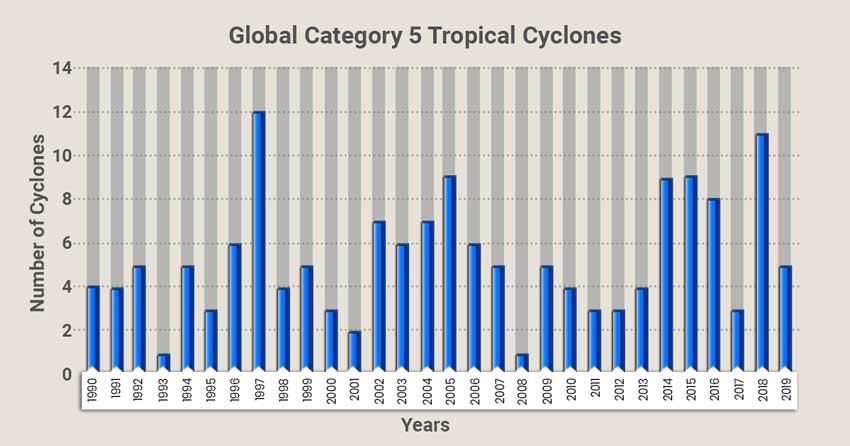
Cyclonic storms are well known weather phenomenon across the world. They are known for causing destruction while travelling through landmass, bringing torrential rains and damage potential winds.
Like the other weather phenomena across the world, this pattern of cyclonic storms has also not remained untouched by the manmade demon ‘climate change’. With rise in global temperatures and climate warming, tropical storms have taken an aggressive turn in the last few years.
It has been noted that in the last three decades, we have seen tremendous rise both in the frequency as well as the intensity of these cyclonic storms. In fact, strongest of the storms, which is of category 5, are getting further stronger.

According to statistics, world has witnessed 149 category 5 cyclonic storms between 1990 and 2019. Out of this, 59 storms have been recorded in the last decade itself.
Following table gives insight about number of category 5 cyclonic storms recorded in last three decades.
![]()
Hurricane, typhoons and cyclone are the different names kept in different regions across the world. In India, we term these storms by the name of cyclones or tropical storms. These cyclonic storms are the heat engines converting heat energy of the ocean into kinetic energy (winds).
Oceanic waters and their heat potential are the key drivers for formation of any storm. Pacific is the largest and deepest ocean spanning across 63 million sq miles. It contains more than half of the free water on the earth. It extends to both Northern Hemisphere as well as Southern Hemisphere and thus witnesses maximum number of storms in the world.
There is a designated season for the formation of these storms. The promising season for formation of storms in West Pacific is from May to December, where these storms are known as typhoons. Meanwhile, for East Pacific, the season spans from May to November where they are termed as hurricane.
Apart from this, the ocean is host to most dreaded oceanic phenomenon of El Niño, which in turn trigger a greater number of storms, drives Monsoon and raises global temperatures. Cyclones have strong connection with El Niño and IOD (Indian Ocean Dipole).
Combination of warm Pacific Ocean, evolving El Niño or prevailing El Niño results in more number of storms. The El Niño years have seen at least seven Category 5 storms in the world since 1990. The maximum number of Category 5 storm were seen in 1997 that recorded 12 cyclones, followed by 2018 that saw 11 Category 5 storms. Both have been El Niño years.
Presence of IOD also keeps the sea surface temperatures warm, which is the foremost requirement for formation of cyclonic storms. The latest example was seen in India in 2019 that hosted nine cyclonic storms. Though they were not Category 5 storm but there was definitely an increase in frequency.
As we progress further, we are afraid that we would see more such adverse impact of climate change and global warming on the weather across the globe.
Image Credit: wikipedia
Please Note: Any information picked from here must be attributed to skymetweather.com


